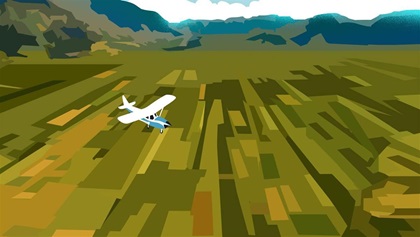We've all been there
5 ways to power through learning plateaus

From day one you’re moving forward—taxiing, then taking off, then learning to control the airplane and make it answer to your control inputs. In a matter of hours you go from being a passenger to being a pilot. This progress is like dopamine, and you can’t wait for your next hit.
Until you reach your first learning plateau...
The steady progress you’ve been making seems to be stuck. You pound away, lesson after lesson. You don’t improve. You do grow frustrated. This type of leveled-out learning seems to strike many student pilots at the landing phase, but it can also happen at any other stage or during preparation for the checkride.
The phenomenon is so common that it has a name: a learning plateau. Pilots of every skill level run into plateaus.
Now that you know what a plateau is, how do you overcome it? First, make sure you talk to your flight instructor about what you think is happening. Then, put a plan into action. Here are five things to try, plus a few out-of-the-box ideas in case the obstacle to your progress is a little more obscure. Your flight instructor is sure to have some suggestions, too.
- Try something different.
Put aside the maneuver that’s got you stuck—landing, slow flight, steep turns, whatever—and work on something else. Something that requires a completely different skill set—such as a short cross-country flight or a night flight—can freshen your enthusiasm for flying. Plus, you’ll check off another requirement to obtain your certificate. - Take a fresh view
It’s your tenth time around the pattern and you can’t figure out the timing of the landing flare. Or the correct sight picture. Or you can’t keep your approach stabilized. Before you grow too frustrated, take a deep breath. Ask your flight instructor to perform a landing from the right seat while you watch everything he does. Or, ask your flight instructor if there’s a different method she can use to teach you the landing. Or, ask her to put you with another flight instructor just for one lesson. Sometimes a different perspective is all it takes to diagnose a problem and prescribe a solution. - Take a break.
If you absolutely are dreading your next flight lesson because you fear more of the same—no progress, more frustration—then it’s OK to postpone your lesson for a few days. Take this time to reflect on all the progress you’ve made. Had you even been in a small airplane a year ago? Could you have imagined yourself taxiing an airplane, let alone landing one? Just don’t let this very brief break turn into a longer hiatus. - Try a simulator.
An FAA-approved simulator can be a great way to break a logjam for certain maneuvers. Take, for example, power-on stalls. If these cause you to clench the yoke and give you sweaty palms, you can experience the stall break, the wing drop, the nose drop, and recovery from the comfort of the simulator instead of at 3,000 feet above ground level. Once armed with the knowledge of what can occur, you’ll be more comfortable in the cockpit performing the stall recovery (see “Thinking Beyond the Routine,” facing page). - Go back to IMSAFE.
Learning plateaus often strike just before a checkride—and that’s a time when pilots are working hard to be ready for the Big Day. Take a moment to check your physical and mental health. Are you getting enough sleep? Are you eating properly? Are you remembering to hydrate before, during, and after the lesson? Use the acronym IMSAFE—Illness, Medication, Stress, Alcohol, Fatigue, Emotion—to evaluate your mental and physical state before each flight lesson (see “Are You Safe? Ask ‘IMSAFE’,” right).

 The Aeronautical Information Manual (AIM) recommends pilots check their physical and emotional health before every flight. Just because we have a CFI sitting next to us is no reason to ignore symptoms that could be problematic during a lesson. Use the IMSAFE checklist to make sure you’re in the best shape to fly an airplane.
The Aeronautical Information Manual (AIM) recommends pilots check their physical and emotional health before every flight. Just because we have a CFI sitting next to us is no reason to ignore symptoms that could be problematic during a lesson. Use the IMSAFE checklist to make sure you’re in the best shape to fly an airplane.  Plateaus are common, and many can be remedied with the general solutions offered here. For some students, however, some brainstorming and some trial-and-error may be necessary before a problem is resolved.
Plateaus are common, and many can be remedied with the general solutions offered here. For some students, however, some brainstorming and some trial-and-error may be necessary before a problem is resolved.


